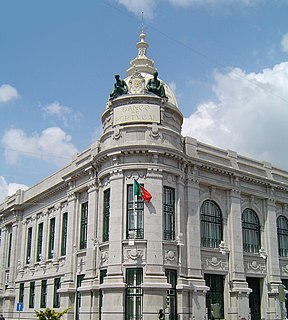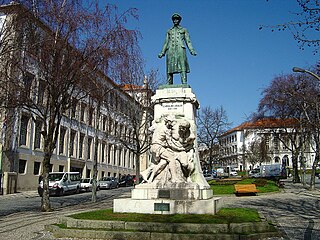| Look up Espinho or espinho in Wiktionary, the free dictionary. |
Espinho may refer to:
| Look up Espinho or espinho in Wiktionary, the free dictionary. |
Espinho may refer to:
| This disambiguation page lists articles associated with the title Espinho. If an internal link led you here, you may wish to change the link to point directly to the intended article. |

Braga is a city and a municipality in the northwestern Portuguese district of Braga, in the historical and cultural Minho Province. The city has a resident population of 192,494 inhabitants, representing the seventh largest municipality in Portugal. Its area is 183.40 km2. Its agglomerated urban area extends from the Cávado River to the Este River. It is the third-largest urban centre in Portugal.

Vila do Conde is a municipality in the Norte Region of Portugal. The population in 2011 was 79,533, in an area of 149.03 km². The urbanized area of Vila do Conde, which includes the parishes of Vila do Conde, Azurara and Árvore, represent 36,137 inhabitants. Vila do Conde is interlinked to the north with Póvoa de Varzim, forming a single urban agglomeration. The town is on the Portuguese Way of the Camino de Santiago.

Maia is a municipality in the Porto Metropolitan Area, Grande Porto subregion, in Norte Region, Portugal. It is located 11 km north of central Porto. The population in 2011 was 135,306, in an area of 82.99 km². There is one city and three towns in the municipality.

The Porto Metropolitan Area is a metropolitan area in northern Portugal centered on the City of Porto, Portugal's second city. The metropolitan area, covering 17 municipalities, is the second largest urban area in the country and one of the largest in the European Union, with a population in 2011 of 1,721,038 in an area of 2,040.31 km².

Espinho is a city and a municipality located in the Aveiro District, Portugal. It is located in both the Greater Porto and the Metropolitan Area of Porto, 16 km from its city centre. It is one of the smallest municipalities in Portugal and was, until 1899, part of the Santa Maria da Feira Municipality.

Mortágua is a municipality in the district of Viseu, Portugal. The population in 2011 was 9,607, in an area of 251.18 km².

Mangualde is a municipality in the subregion of Dão-Lafões, central region of Portugal. The population in 2011 was 19,880, in an area of 219.26 km2.

Rio Dão is a Portuguese river that originates in the plateau regions of Trancoso-Aguiar da Beira in the Eirado parish, Aguiar da Beira Municipality, Guarda District, and varies between 714 and 757 metres in elevation.

Espinho is a Portuguese freguesia, located in the municipality of Braga. The population in 2011 was 1,181, in an area of 4.48 km². The Sameiro Sanctuary is situated in Espinho.

Vila Real is the capital and largest city of the Vila Real District, northern Portugal. The population in 2011 was 51,850, in an area of 378.80 square kilometres (146.26 sq mi).

Abrunhosa-a-Velha is a civil parish in the municipality of Mangualde in the central sub-region of Dão-Lafões in Portugal. The population in 2011 was 563, in an area of 17.30 km².

Mangualde, Mesquitela e Cunha Alta is a civil parish in the municipality of Mangualde, Portugal. It was formed in 2013 by the merger of the former parishes Mangualde, Mesquitela and Cunha Alta. The population in 2011 was 10,407, in an area of 46.25 km².

Espinho is a freguesia in Mangualde, Portugal. The population in 2011 was 984, in an area of 14.55 km².

Mangualde is a former civil parish in the municipality of Mangualde, Portugal. In 2013, the parish merged into the new parish Mangualde, Mesquitela e Cunha Alta.

The Dolmen of Cunha Baixa is a dolmen in the civil parish of Cunha Baixa, in the municipality of Mangualde. It is located in a valley area of the Rio Castelo, between the villages of Cunha Baixa and Espinho.

Quintela de Azurara is a civil parish in the municipality of Mangualde, Portugal. The population in 2011 was 542, in an area of 9.59 km².
The 2019–20 Taça de Portugal was the 80th edition of the Taça de Portugal, the premier knockout competition in Portuguese football. A total of 144 clubs entered this edition, including teams from the top three tiers of the Portuguese football league system and representatives of the fourth-tier District leagues and cups. This was the first season to allow a fourth substitution during extra time.